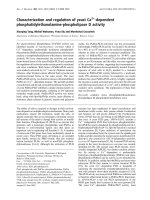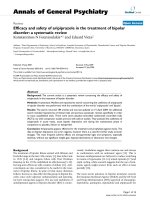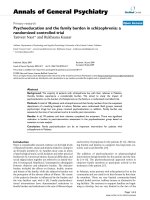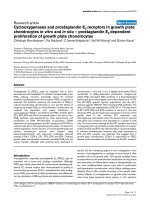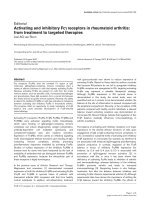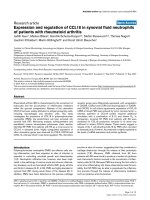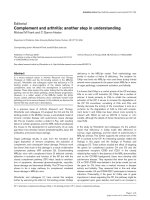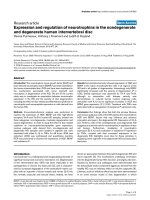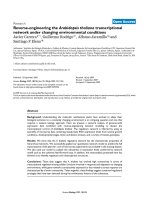Báo cáo y học: " Psychoeducation and the family burden in schizophrenia: a randomized controlled trial" docx
Bạn đang xem bản rút gọn của tài liệu. Xem và tải ngay bản đầy đủ của tài liệu tại đây (180.27 KB, 6 trang )
BioMed Central
Page 1 of 6
(page number not for citation purposes)
Annals of General Psychiatry
Open Access
Primary research
Psychoeducation and the family burden in schizophrenia: a
randomized controlled trial
Tanveer Nasr* and Rukhsana Kausar
Address: Department of Psychology and Applied Psychology, University of the Punjab, Lahore, Pakistan
Email: Tanveer Nasr* - ; Rukhsana Kausar -
* Corresponding author
Abstract
Background: The majority of patients with schizophrenia live with their relatives in Pakistan,
thereby families experience a considerable burden. We aimed to study the impact of
psychoeducation on the burden of schizophrenia on the family in a randomised controlled trial.
Methods: A total of 108 patients with schizophrenia and their family members from the outpatient
department of a teaching hospital in Lahore, Pakistan were randomised. Both groups received
psychotropic drugs but one group received psychoeducation in addition. Family burden was
assessed at the time of recruitment and at 6 months post intervention.
Results: In all, 99 patients and their relatives completed the treatment. There was significant
reduction in burden at post-intervention assessment in the psychoeducation group based on
intention to treat analysis.
Conclusion: Family psychoeducation can be an important intervention for patients with
schizophrenia in Pakistan.
Introduction
There is considerable research evidence on the high levels
of financial burden, strain and distress related to caring for
an ill family member [1-3]. Families incur costs in terms
of psychological strain, social isolation and other practical
burdens [4-6]. Emotional strains, financial difficulties and
social stigma taken together are referred to as family bur-
den. Hoening and Hamilton [7] attempted to distinguish
between objective and subjective burden. The objective
burden included the effects on finance, health, routine
and leisure of the family, while the subjective burden was
the perception of the adverse effects of illness. The course
of the patient's disorder is influenced by the burden and
the way families cope with it [8]. Family psychoeduca-
tional interventions have demonstrated reductions in
family burden and reductions in the rate of illness relapse
and severity of symptoms for the patients [9-12]. Alleviat-
ing burden and distress in caregivers has important eco-
nomic and social benefits [13].
The addition of psychoeducation to pharmacological
interventions brings benefits for the patient and the fam-
ily [14-16]. The psychoeducational approach strives to
empower family members to participate actively in the
treatment of the patient [17].
In Pakistan, most patients with schizophrenia live in the
community and are cared for in their homes by their fam-
ily members. There are very limited community-based
mental health services, halfway houses or alternative liv-
ing facilities. The resources to support families are begin-
ning to develop, but are very limited in the face of the
Published: 28 July 2009
Annals of General Psychiatry 2009, 8:17 doi:10.1186/1744-859X-8-17
Received: 16 June 2009
Accepted: 28 July 2009
This article is available from: />© 2009 Nasr and Kausar; licensee BioMed Central Ltd.
This is an Open Access article distributed under the terms of the Creative Commons Attribution License ( />),
which permits unrestricted use, distribution, and reproduction in any medium, provided the original work is properly cited.
Annals of General Psychiatry 2009, 8:17 />Page 2 of 6
(page number not for citation purposes)
huge demand. The reduction of family burden can help
the families to sustain their caring role.
In the comprehensive Cochrane review of family interven-
tions for schizophrenia that was updated in 2006, there
was no study of family psychoeducational intervention
from Pakistan [18]. In our literature search we could not
identify any publications in this area from Pakistan.
In this paper, we report the results of a randomised con-
trolled trial of the effects of psychoeducation on the fam-
ily burden in Pakistan.
Methods
This study had a between-group design and compared two
sets of participants (patients and their family members).
One group of family members received psychoeducation
in addition to psychotropic drugs, and the other group
received psychotropic drugs only. Both groups were
assessed twice, prior to and 6 months after the psychoed-
ucational intervention.
Sample
The sample consisted of 108 patients of mixed sex and
their family members; there were 52 in the group who
received psychoeducation and 56 in the group who did
not receive psychoeducation. The Diagnostic and Statisti-
cal Manual of Mental Disorders, fourth edition text revi-
sion (DSM-IV TR) diagnostic criteria were used for the
selection of patients with schizophrenia.
Patients included in the study ranged in age between 18
and 45 years and had a history of two or more relapses
during the course of their illness despite getting treatment.
The patients and their families included in the study had
homogenous sociodemographic characteristics. Patients
manifesting schizophrenia-like symptoms due to any
organic disorder such as dementia or any other cognitive
impairment, abuse of alcohol or of drugs acting on the
central nervous system and those with clinical evidence of
epilepsy or intellectual disability were excluded.
One adult relative living with the patient in the same
property, and who had maximum interaction with the
patient or who was directly involved with the patient was
included in the study. Mostly these were parents, spouses,
siblings or any other significant relative. Family members
with at least 5 years of school education were included so
that they were able to understand and follow researchers'
instructions and read the psychoeducation package.
Assessment and intervention measures
At the time of first assessment a demographic information
questionnaire was used to collect information regarding
the demographic characteristics of the patient and the par-
ticipating relative. The questionnaire was designed to col-
lect information about age, sex, educational level, birth
order, number of siblings, marital status, number of chil-
dren, occupation and work status, and to gather details
about the illness (age at onset, number of admissions in
hospital, number of relapses, family history of mental ill-
ness and so on). The participant relatives' demographics
included age, sex, education and relationship with the
patient.
Family Burden Interview Schedule (FBIS)
Pai and Kapur's Family Burden Interview Schedule [19]
was used to assess family burden. The FBIS assesses the
burden placed on families of psychiatric patients living in
the community setting. This scale measures objective and
subjective aspects of burden and it contains six general
categories of burden, each having two to six individual
items for further investigation. Subcategories include:
financial burden, effects on family routine, effects on fam-
ily leisure, effects on family interaction, effects on physical
health of family members and effects on mental health of
other family members. Each item is rated on a three-point
scale, where 0 is no burden and 2 is severe burden.
Psychoeducation intervention package
The psychoeducation package used in the current study
was modelled after the psychosocial family intervention
package used by Kuipers and Leff [20]. The psychoeduca-
tion booklet was translated into Urdu for the participants
of the current study. The important components of the
package are summarised below.
The intervention begins with providing information to
family members about schizophrenia, and how it affects
the persons' thoughts, emotions and behaviour. A
detailed account of symptoms is provided. Disturbances
in sensory perception and their effects on the behaviour of
the patient are explained.
The family receives information about the possible causal
factors. The family is informed about factors that influ-
ence the occurrence of schizophrenia, including genetics,
neurochemistry, biological factors, life stressors and inter-
personal and social factors.
The family and patient are educated about the treatment
in detail. This component includes information about
medication, its side effects and how these can be dealt
with, likely benefits of the medicine, adherence to treat-
ment, the importance of follow-up and information
regarding prognosis.
The intervention emphasises the role the family can play
in helping the patient to stay well. The intervention assists
the families to improve their communication skills.
Another important component of psychoeducation is to
address the emotional upset in family members. A thera-
Annals of General Psychiatry 2009, 8:17 />Page 3 of 6
(page number not for citation purposes)
pist helps family members to normalise the negative emo-
tional responses by providing information regarding
these issues.
One of the important aspects of the education package
was to address family concerns and highlight their role in
patient recovery and rehabilitation, which in turn will
reduce the burden on family members. Family members
were encouraged to address their own needs and to
resume their former personal and social interests, which is
imperative for their own mental health.
Procedure
The project had ethical approval from University of the
Punjab. Written informed consent from the participating
patient and the accompanying family member was sought
for participation in the research. A researcher personally
assessed patients and relatives for suitability to participate
in the study. The diagnosis for each patient was confirmed
using DSM-IV TR criterion. The researcher was not
involved in the randomisation of the patients and fami-
lies, which was performed at the institution.
The participating family members were required to com-
plete a family burden interview schedule before they par-
ticipated in the intervention programme. The patients in
the non-psychoeducation group, as well as their partici-
pant family members, were assessed using same tools at
the same time.
Psychoeducation sessions were arranged in hospital set-
tings. All the sessions were carried out individually with
family and the patient at the Department of Psychiatry,
Mayo Hospital, Lahore, Pakistan. Education sessions were
based on a specially designed information booklet.
The first session aimed to provide general information
about schizophrenia, its nature, types and causes. Com-
mon stereotypes were discussed and dispelled, providing
accurate information about illness. In the second session,
schizophrenia was explained as a syndrome affecting
thoughts and emotions, which in turn results in disturbed
behaviour. The distinction between positive and negative
symptoms was explained so that relatives could under-
stand the illness.
The third session focused on the importance of pharma-
cological treatment; information about side effects and
the likely benefits of medication in acute and mainte-
nance phase were described. The role of medication in
relapse prevention was outlined. The important role of
the family in recovery and rehabilitation of the patient
was clarified. The fourth educational session provided
general advice encouraging family members to address
their personal and social needs to improve their well-
being and to resume their formal social interests.
The family members of the patients who received psych-
oeducation attended a total of nine therapeutic sessions.
Information about schizophrenia and its treatment was
provided to family members in four sessions, held weekly.
Sessions were interactive and participation was encour-
aged, which gave rise to further discussions. Families were
encouraged to ask questions. In five follow-up sessions a
monthly formal contact with the patient and participating
relative was maintained.
In follow-up sessions, the clinical condition of the patient
as reported by the family and patient was recorded. The
family as well as the patient were invited to discuss any
problems that they encountered during that period and
any incidences of emotional upset, communication prob-
lems or relationship problems, and they were counselled
accordingly. The average time for the two initial educa-
tional sessions was 1.5 h, and subsequent sessions were
30 to 40 minutes.
When the patient was in a stable phase a session was con-
ducted with him/her individually, in which he/she was
also educated regarding the nature and process of illness
using the same educational pattern as was used for the
family. However, while educating patients, the main
emphasis was on compliance with pharmacological treat-
ment and the likely benefits of taking medicine as well as
advice for regular follow-up and to resume the normal
day-to-day routine.
The patients in both groups were receiving equivalent
doses of medication, but the psychoeducation group had
the additional advantage of psychoeducational sessions.
The Urdu version of the psychoeducation booklet was dis-
tributed among participating relatives so that they could
share knowledge with the remaining family members. The
participating relatives in the two groups were requested to
complete the FBIS after the completion of psychoeduca-
tion in the psychoeducation group.
Statistical analysis
We analysed the data with SPSS V. 15 (SPSS, Chicago, IL,
USA). The categorical variables were compared using the
χ
2
test. We treated the FBIS scores as interval variables and
used the t test to look at differences in the groups. For age
and income we used the t test to compare groups. We uti-
lised an intention to treat analysis for the analysis of fam-
ily burden scores.
Results
Characteristics of the sample
A total sample of 108 patients were recruited and ran-
domly assigned to the psychoeducation group (n = 52) or
the non-psychoeducation group (n = 56). In all, 100
patients completed the treatment. One patient from the
Annals of General Psychiatry 2009, 8:17 />Page 4 of 6
(page number not for citation purposes)
psychoeducation group had died by the 6-month follow-
up period. Of the 108 patients, 58 (57.3%) were males
and 50 (46.7%) were females. The mean age of the treat-
ment group patients was 25.31 years (SD 7.02) and for
control group was 27.00 years (SD 7.29). Table 1 gives the
characteristics of the two groups.
The two groups were similar and comparable in demo-
graphic characteristics. There were no significant differ-
ences between the two groups for age, gender, educational
level, marital status or length of illness.
Most of the relatives were females (mothers, sisters and
daughters). Relatives were living in the same household as
the patient. The majority of the relatives had a primary
level of education and about one-third had completed
their education up to secondary school (Table 2).
To examine the efficacy of the psychoeducation interven-
tion in reducing family burden in families of patients with
schizophrenia, the subscale scores were derived according
to the scoring method described by the authors. Scores for
each scale were worked out by summing item scores.
Owing to the varied number of items in different sub-
Table 2: Demographic characteristics of the participant family members
Variable Psychoeducation group (n = 52), n (%) Non-psychoeducation group (n = 56), n (%) P value
Sex: 0.54
Male 16 (30.8%) 21 (37.5%)
Female 36 (69.2%) 35 (62.5%)
Mean (SD) age of relative, years 41.84 (11.31) 44.25 (13.29) 0.31
Education: 0.51
Up to 5 years 15 (28.7%) 22 (39.3%)
5 to 10 years 20 (38.5%) 18 (32.1%)
Over 10 years 17 (32.7%) 16 (28.6%)
Relationship with patient: 0.59
Father 8 (15.4%) 12 (21.4%)
Mother 24 (46.2%) 25 (44.6%)
Spouse 6 (11.5%) 2 (3.6%)
Sister 6 (11.5%) 5 (8.9%)
Brother 4 (7.7%) 7 (12.5%)
Daughter 4 (7.7%) 5 (8.9%)
Table 1: Demographic characteristics of the patients
Variable Group P values
Experimental (n = 52) Control (n = 56)
Sex:
Male, n (%) 26 (50%) 32 (57.1%) 0.56
Female, n (%) 26 (50%) 24 (42.9%)
Mean (SD) age, years 25.31 (7.02) 27.00 (7.29) 0.22
Current work status, n (%):
Working 5 (9.6%) 8 (14.3%) 0.45
Not working 47 (90.4%) 48 (85.7%)
Education, n (%):
Up to 5 years 5 (9.6%) 9 (16.1)
5 to 10 years 28 (53.8%) 28 (50%)
More than 10 years 19 (36.5%) 19 (33.9%)
Mean (SD) family income in Pakistan Rupees 9,569 (5,032) 8,335 (5,983) 0.25
Marital status, n (%):
Married 11 (21.2%) 12 (21.4%) 0.27
Unmarried 40 (76.9%) 39 (69.6%)
Divorced 1 (1.9%) 5 (8.9%)
Patient living with, n (%):
Spouse 9 (17.3%) 8 (14.3%)
Parents 42 (78.8%) 45 (80.4%) 0.86
Siblings 2 3 (5.4%)
Annals of General Psychiatry 2009, 8:17 />Page 5 of 6
(page number not for citation purposes)
scales, standard scores were computed. An independent
samples t test was computed to compare the two groups
on burden for pre-intervention and post-intervention
scores. The results are given in Table 3.
Pre-intervention analysis revealed no differences in scores
from the psychoeducation and non-psychoeducation
group except for routine. Family members in the psych-
oeducation group reported a significantly greater burden
for the 'routine' score as compared to the non-psychoedu-
cation group.
To examine the differences in burden level between the
two groups post intervention, an independent t test anal-
ysis was carried out. The results are displayed in Table 4.
There was a significant difference in post-intervention
measures of burden in most categories. The groups were
not different in the physical health category, and in finan-
cial category the result was just above 5% significance.
We finally compared the two groups while controlling for
the pre-intervention scores. The results are shown in Table
5. The results show that if the baseline scores are control-
led for, then the difference between the groups is signifi-
cant for all categories of burden.
The results showed a significant reduction in the level of
burden in families who received psychoeducation as com-
pared to those who did not receive psychoeducation. The
psychoeducation group scored significantly lower on
financial burden, social interaction and psychological
health compared to the non-psychoeducation group. In
the initial analysis both groups did not differ in burden in
terms of leisure activities and effects on physical health.
These differences became significant when the pre-inter-
vention scores were taken into consideration.
Discussion
The present study examined the role of psychoeducation
in the alleviation of family burden. Patients with schizo-
phrenia were randomly allocated to one of two groups, a
psychoeducation group or a non-psychoeducation group.
The findings of the present study showed that families
receiving psychoeducation reported significantly lower
burden compared to those who did not receive psychoed-
ucation. Care for patients with schizophrenia at home
constitutes a considerable burden on the family. Despite
Pakistan having an extended family system, which is sup-
portive in times of stress, the families of patients with
schizophrenia were experiencing burden. It is clear that
families feel an appreciable burden and find it difficult to
cope with schizophrenia. They often lack knowledge
about the nature of the patient's illness and receive little
help from professionals for the management of the
patients' behaviour. Coping with the patients' problems
frequently results in adverse effects on physical and psy-
chological health of the family members, so relatives
should be provided with more information regarding ill-
ness and be given more support to alleviate the distress
they feel [21].
Our findings are important because we have tested this
intervention for the first time in Pakistan using measures
that were developed in India, a country with a similar cul-
ture. Although there is plenty of literature from developed
countries confirming the effectiveness of this approach
Table 4: Independent samples t test comparing two groups post intervention on family burden
Treatment group, mean (SD) Control group, mean (SD) t Value P value
Financial 2.37 (1.6) 3.00 (1.78) -1.93 0.056
Routines 1.46 (1.61) 2.38 (1.95) -2.63 0.01
Leisure 1.77 (2.08) 3.46 (2.24) -4.05 0.000
Interaction 1.33 (1.68) 2.80 (2.08) -4.02 0.000
Physical health 1.29 (1.70) 1.57 (2.15) -0.75 0.45
Psychological health 1.00 (1.35) 1.75 (2.16) -2.13 0.035
Table 3: Independent samples t test analysis comparing two groups on pre-intervention family burden
Burden subgroup Treatment group, mean (SD) Control group, mean (SD) t Value P value
Financial 4.23 (2.13) 3.57 (2.13) 1.6 0.11
Routines 4.54 (1.60) 3.70 (1.91) 2.46 0.01
Leisure 4.25 (2.44) 4.11 (2.41) 0.30 0.76
Interaction 3.33 (2.10) 3.48 (2.15) 0.37 0.70
Physical health 2.60 (2.71) 2.11 (2.41) 0.99 0.32
Psychological health 2.38 (1.88) 2.07 (2.36) 0.75 0.45
Annals of General Psychiatry 2009, 8:17 />Page 6 of 6
(page number not for citation purposes)
[8], we thought it was important to test this method in
Pakistan to see if it works in this setting.
In the current study, financial burden was high in both
groups at time of preassessment. One could argue that the
discontinuation or loss of job of the patient, as well as the
difficulties faced by caring family members who may find
it hard to continue work because of their extra responsibil-
ities, would contribute to financial burden. Moreover,
expenditures incurred on treatment, medicine, and at
times transport due to hospitalisation away from home is
also added reasons for financial burden on families. Our
findings are in agreement with those of Rouget and Aubry
[22], who in their study also reported financial burden in
families of patients with schizophrenia. Bhagyalaxmi and
Raval [23] also found (moderate to severe) financial bur-
den in 86% of affected families.
The majority of the carers in current study, and other
related studies, are women, so special attention needs to
be paid to their needs in order to help them and share the
responsibilities that these relatives have taken on. In the
Pakistani context, the carers may benefit from support
from members of the extended family to decrease the bur-
den of care. Provision of respite care services is non-exist-
ent in Pakistan, even in big cities.
The development of an informal support network for
patients and their families could reduce their isolation
and burden and, in the majority of cases, should be a fea-
sible option in Pakistan.
Psychoeducation should be offered to families as a matter
of routine in Pakistan, and policymakers need to take
these finding into account when planning services.
As financial burden is an important component of the
total burden for the families, more local services provided
either free or at a subsidised rate could reduce the burden.
Competing interests
This was TN's PhD project.
Authors' contributions
The project was jointly conceived and planned by both
the authors. TN collected the data under supervision by
RK. The paper was jointly written by both the authors.
References
1. Gibson JS, Horn SH, Powell JM, Gibbson JL: Schizophrenic
patients and their families: a survey in psychiatric services
based on a DGH unit. Br J Psychiatry 1984, 144:70-77.
2. Bulger MW, Wandersman A, Goldman CR: Burdens and gratifica-
tions of caregiving: appraisal of parental care of adults with
schizophrenia. Am J Orthopsychiatry 1993, 63:255-265.
3. Lehman AF, Steinwachs DM: Patterns of usual care for schizo-
phrenia: initial results from the schizophrenia out come
research team treatment recommendations. Schizophrenia
Bull 1998, 24:11-20.
4. Cheng LY, Chan S: Psychoeducation program for Chinese fam-
ily carers of members with schizophrenia. West J Nurs Res
2005, 27:583-599.
5. Magliano L, Marasco C, Fiorillo A, Malangone C, Guarneri M, Maj M,
Working Group of the Italian National Study on Families of Persons
with Schizophrenia: The impact of professional and social net-
work support on the burden of families of patients with
schizophrenia in Italy. Acta Psychiatr Scand 2002, 106:291-298.
6. McDonell MG, Short RA, Berry CM, Dyck DG: Burden in schizo-
phrenia care givers impact; Family psychoeducation and
awareness of patient suicidality. Fam Process 2003, 42:91-103.
7. Hoening J, Hamilton M: The desegregation of the mentally ill.
London, UK: Routledge and Kegan Paul; 1969.
8. Roick C, Heider D, Toumi M, Angermeyer MC: The impact of car-
egivers characteristics, patients conditions and regional dif-
ferences on family burden in schizophrenia: a longitudinal
analysis. Acta Psychiatr Scand 2006, 114:363-374.
9. Dyck DG, Hendryx MS, Short RA, Voss WD, McFarlane WR: Serv-
ice use among patients with schizophrenia in psychoeduca-
tional multiple-family group treatment. Psychiatr Serv 2002,
53:749-754.
10. Hogarty GE, Anderson CM, Reiss DJ, Kornblith SJ, Greenwald DP,
Javna CD, Madonia MJ: Family psychoeducation, social skills
training, and maintenance chemotherapy in the aftercare
treatment of schizophrenia: I. One-year effects of a control-
led study on relapse and expressed emotion. Arch Gen Psychiatr
1986, 43:633-642.
11. Leff J, Berkowitz R, Shavit N, Strachan A, Glass I, Vaughn C: A trial
of family therapy v. a relatives group for schizophrenia.
Br J
Psychiatry 1989, 154:58-66.
12. McFarlane WR, Link B, Dushay R, Marchal J, Crilly J: Psychoeduca-
tional multiple family groups: four-year relapse outcome in
schizophrenia. Family Process 1995, 34:127-144.
13. Dixon L, Lucksted A, Stewart B, Burland J, Brown CH, Postrado L,
McGuire C, Hoffmann M: Outcomes of the peer-taught 12 week
family to family education program for severe mental illness.
Acta Psychiatr Scand 2004, 109:207-215.
14. Tarrier N, Barrowclough C, Vaughn C, Bamrah JS, Porceddu K, Watts
S, Freeman H: Community management of schizophrenia: a
two-year follow-up of a behavioural intervention with fami-
lies. Br J Psychiatry 1989, 154:625-628.
15. Tarrier N, Barrowclough C: Family interventions for schizo-
phrenia. Behav Modif 1990, 14:408-440.
16. Magliano L, Fiorillo A: Psychoeducational family interventions
for schizophrenia in the last decade: from explanatory to
pragmatic trials. Epidemiologia e Psichiatria Sociale 2007, 16:22-34.
17. Bäuml J, Froböse T, Kraemer S, Rentrop M, Pitschel-Walz G: Psych-
oeducation: a basic psychotherapeutic intervention for
patients with schizophrenia and their families. Schizophrenia
Bull 2006, 32(Suppl 1):S1-9.
18. Pharoah F, Mari J, Rathbone J, Wong W: Family intervention for
schizophrenia. Cochrane Database Syst Rev 2006, 4:CD000088.
19. Pai S, Kapur RL: The burden on the family of a psychiatric
patient: development of an interview schedule. Br J Psychiatry
1981, 138:332-335.
20. Kuipers L, Leff JP, Lam DH: Family work for schizophrenia – a
practical guide. London, UK: Gaskell Press/Royal College of Psy-
chiatrists; 1992.
21. Fadden G, Bebbington P, Kuipers L: The burden of care: the
impact of functional psychiatric illness on the patients' fam-
ily. Br J Psychiatry 1987, 150:
285-292.
22. Rouget BW, Aubry JM: Efficacy of psychoeducational
approaches on bipolar disorders: a review of the literature. J
Affect Disord 2007, 98:11-27.
23. Bhagyalaxmi A, Raval VS: A study of the effects of illness experi-
enced by families of oral and oropharyngeal cancer patients.
Indian J Comm Med 2003, 27:30-34.
